

What is the average cost of daycare?
For any new parent or parent-to-be, one of the most dreaded questions is, "How much does daycare cost?" It's something we don't think about until we have children. Yet, given the high cost of child care, we should plan for the financial impact of daycare and preschool long before we start thinking about having children.
Spoiler alert: there's no easy answer to the question "How much does daycare cost?" Luckily, we've built a nifty daycare cost calculator to help parents estimate the average cost of child care in their area (scroll down below.)
There's no easy answer because the average cost of child care varies based on your location, child's age, and whether it's a daycare center or home daycare. In this article, you will find the average cost of care for infants, toddlers, and four-year-old preschoolers in states across the U.S.
At the end of the article, you'll learn about the cost of a nanny, babysitter, or Au Pair. Those can also be good options for parents, so we'll discuss how they compare to child care centers, licensed home daycares, and preschools.
In short, the average cost of daycare in the U.S. is $9,649/year, but it can cost anywhere from $2,813/year to $23,666/year. The lowest price is for a home-based program for a 4-year-old in Mississippi, and the most expensive is infant care in a center in Washington D.C. That's quite a broad range!
In the daycare cost calculator below, enter your zip code, age of your child, and type of care you prefer. The tool will give you an estimate of the average cost of child care near you, using CareLuLu proprietary data supplemented by Statewide average costs¹. As a bonus, you will also get a list of licensed daycares and preschools near you. You can then click to learn about various child care programs and compare the cost, photos, reviews, and more!
Where are you looking for child care?
How old is your child?
What type of child care do you prefer?

Center

Home
Calculate
The U.S. average cost of child care and preschool
Table 1 below shows the national average cost of child care for infant care, toddler care, and preschool for four-year-old children. Costs are split by type of program, center-based, and home-based.
In general, infant care is the most expensive, with an average of $9,321/year in a home-based daycare and $11,959/year for child care centers. Preschool programs for older children tend to be more affordable with an average cost of care for 4-year-old between $8,617/year and $9,170/year (for home-based and center-based programs, respectively.)
Table 1. The U.S. Average Cost of Child Care (Per Year) ²
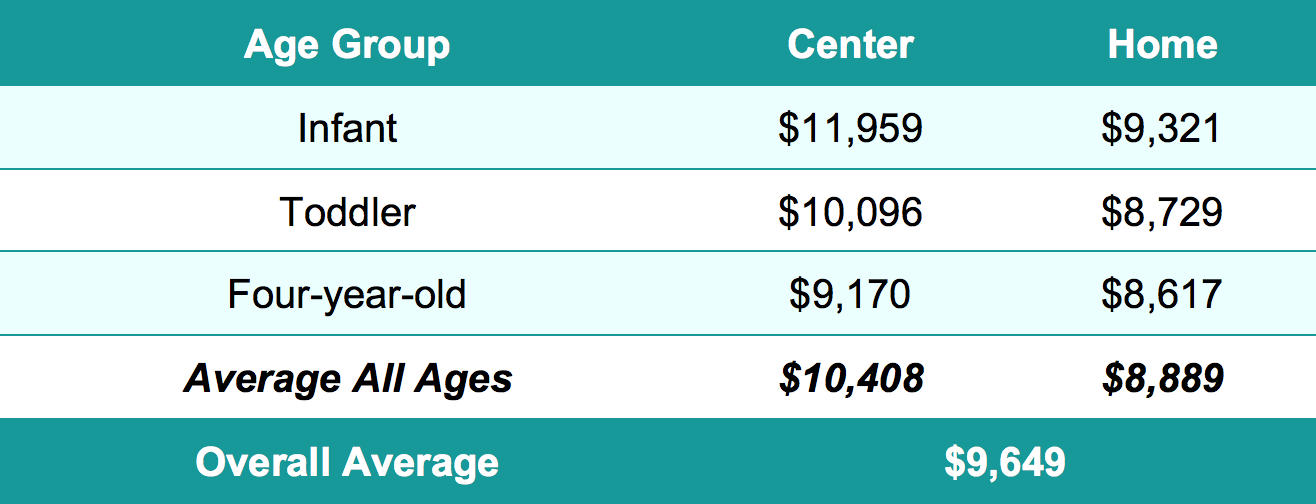
The States where daycare is the least and most expensive by age group
Since each State has a unique landscape in terms of family income, child care availability and prices, the cost of child care needs to be analyzed State by State. Tuition rates also depend a lot on the age of the child (as explained earlier, daycare prices for infants are in general higher than for toddlers or preschoolers).
The District of Columbia has the highest cost of infant care for both settings, with $23,666/year and $16,737/year for a daycare center and a home daycare, respectively. As a point of comparison, D.C.'s average infant care costs more than the most expensive public college tuition in the U.S. (which is in New Hampshire, with $16,073 per year)! The lowest cost for infant care is in Mississippi, where the average price for daycare centers is $5,307/year, while the average for a family child care program is $3,570/year.
Table 2. Highest & Lowest Average Cost of Child Care for Infants (Per Year) ²
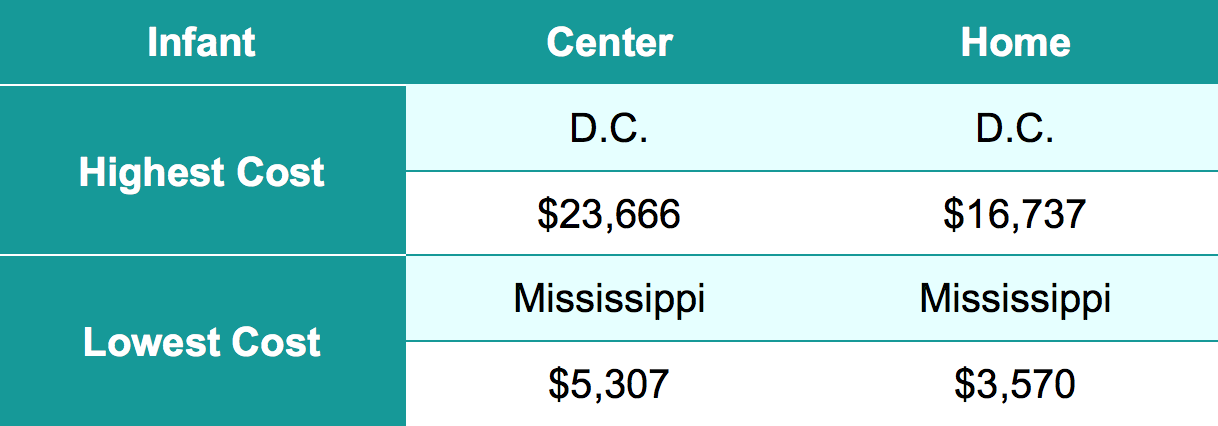
For toddlers, the cost decreases considerably on the high-end. The most expensive State for center-based toddler care is Massachusetts, with an annual cost of $18,845 on average. For in-home daycares, Nebraska is the costliest for toddlers, with an average yearly price of $12,480. On the low-end, the least expensive States for toddlers are Kentucky (for center-based child care) and South Carolina (for home-based), where cost is $6,258/year and $4,797/year, respectively.
Table 3. Highest & Lowest Average Cost of Child Care for Toddlers (Per Year) ²
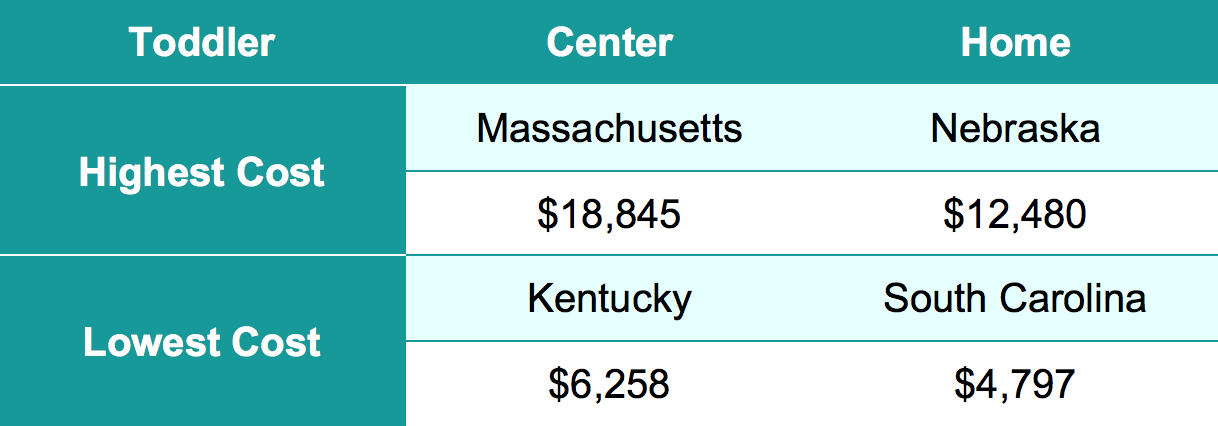
The average cost of care continues to decrease as children get older. For most States, this is because regulations typically require lower teacher-to-child ratios. This means that a child care business can enroll more children with one teacher or caregiver. With lower staff costs, daycares and preschools can offer lower tuition.
It's important to note that even though staff costs are one of the major expenses for child care businesses (along with real estate), child care providers are unfortunately one of the lowest-paid professions in the U.S.
Washington D.C. once again takes the top spot when it comes to the most expensive State. For a 4-year-old in private preschool, the cost of care is on average $18,657/year in center-based programs and $14,293/year for home-based preschools. Similarly to infants, Mississippi is once again the State with the lowest cost for 4-year-olds: the average price for centers is $4,670/year, while the average for an in-home preschool is $2,813/year.
Table 4. Highest & Lowest Average Cost of Child Care for 4-Year-Olds (Per Year) ²
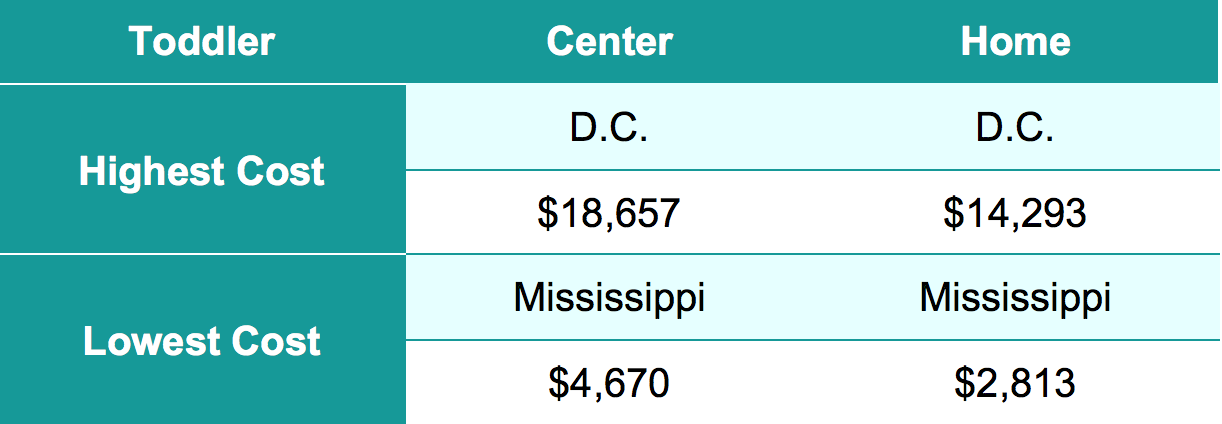
Can families in the U.S. find affordable daycare?
While these numbers are interesting, amounts don't say much until we answer the question of, “How much of their income do families spend on child care?” According to the U.S. Department of Health and Human Services recommendation, child care should not represent more than 7% of a family's household income.
Given the $9,649/year average cost of child care and the U.S. median annual household income of $60,336, parents spend on average 16.0% of their income on child care.
This number varies by age group since the cost of care decreases as children get older. For infants, parents spend 15.4% to 19.8% of their income on child care (nationwide average for home daycares and child care centers, respectively). For toddlers, parents spend a bit less, with an average of 14.5% and 16.7% of the median annual income, for home-based and center-based daycares, respectively. For 4-year-old preschoolers, families spend between 14.3% and 15.2%. Center-based programs, once again, take a more substantial chunk of the family's budget.
Table 5. Percentage of Family Income Spent on Child Care by Age Group (U.S. Average)
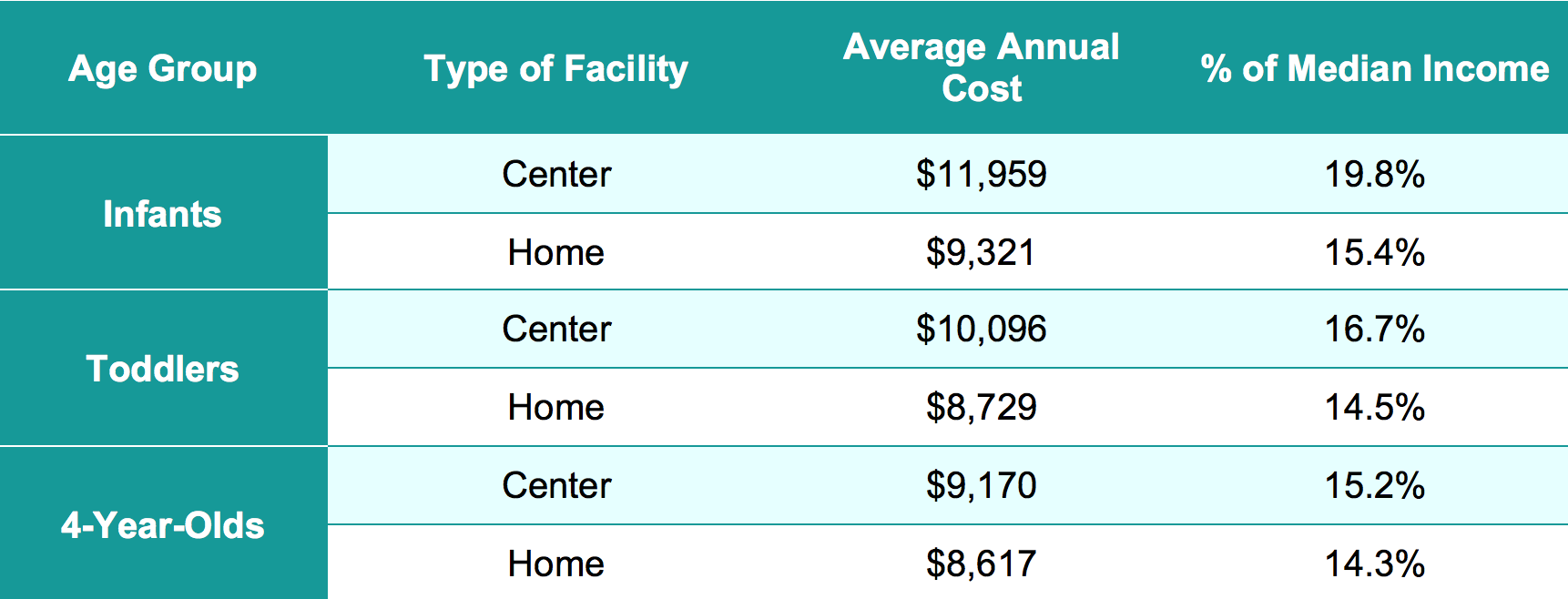
Which States have the least and most affordable daycare?
The situation is much worse in some States than others. The State where infant care is the least affordable for single-parent families is D.C., where center-based infant care costs as much as 91% of the median household income (or 64.4% for in-home daycares). For married-couple families, California is the least affordable for center-based infant care (18.6% of household income), and Nebraska is the least accessible for in-home infant care (14.6% of household income). On the other hand, the State with the most affordable infant care is Mississippi, with the average cost representing 4.9% to 7.3% of the median household income for a married couple.
Table 6. Affordability of Child Care for Infants (% of Median Income Spent on Child Care)

For 4-year-old children in preschool, Mississippi remains the most affordable State with child care costing 3.9% to 6.4% of the household income for married-couple families (14.7% to 24.4% for single-parents). The District of Columbia remains the least affordable for single-parent families, where child care costs for 4-year-old children represent 55% to 71.7% of the income. For married couples, D.C. is the least affordable for center-based care (13.1% of household income), and Nebraska is the least affordable for home-based preschools (14.6% of household income).
Table 7. Affordability of Child Care for 4-Year-Olds (% of Median Income Spent on Child Care)

Is hiring a nanny, babysitter, or an au pair a good option?
Given the high cost of child care centers and home daycares, some parents may consider a caregiver that will solely care for their child. Hiring a nanny, babysitter or an Au Pair can all be good options, depending on each family's needs. When it comes to cost, though, home daycares and child care centers aren't the most expensive options.
According to the 2017 INA Nanny Salary and Benefits Survey, the average hourly rate in the U.S. is $19.14 per hour. Assuming 40-hour weeks, a nanny costs $39,811 per year on average. Nannies are employed by the family and thus also get paid holidays, vacation and sick days, health insurance, and other benefits. A nanny may be a good financial option for families with 3 or more children, but for 1 or 2 children, group child care is certainly more affordable. Of course, there are a variety of non-financial reasons why a family may prefer a nanny.
Au Pairs can cost about $19,000 to $20,000 per year or more, depending on a few factors. Au Pairs must receive a weekly stipend from the host family that is at least $195.75 per week, though families can pay more than this legal minimum. This stipend is about $10,000 per year, to which families need to add agency fees that cost $8,000 to $9,000. A few other costs also need to be taken into consideration when thinking about an Au Pair. For instance, room and board, auto insurance if they drive your car as well as travel costs to facilitate attendance at education classes or au pair gatherings.
Babysitters typically earn a rate similar to that of nannies but are more flexible in terms of hours and provide more short-term care. Just like nannies, babysitter hourly rates vary a lot by location and experience but can be anywhere from $10-$15/hour to $25-$30/hour or more.
Why is daycare so expensive, and what factors impact child care cost?
In addition to knowing the average cost of daycare, it's also essential to understand where your tuition fees go. Knowing what influences the cost of child care can help you decide what's most important to you, and what you don't feel is essential so that you can save on child care.
The factors impacting the cost of daycare are (but not limited to) the following:
● Labor cost – caring for a child remains a hands-on job, and quality child care often equates to individual attention. Child care businesses pay staff, taxes, benefits, maintain high standards, and generally have low teacher-to-child ratios, especially for infants. In general, early childhood educators represent about 80% of child care expenses.
● Location, location, location – where you live is a significant factor in the cost of daycare, as the price varies between states, counties, and even cities. Child care tends to be more expensive in large metro areas, simply because real estate is more costly, salaries are higher, etc. To save on child care, parents can consider commuting (or moving) a bit further away from the center of large cities.
For instance, if you work in the Washington D.C. metro area, consider looking for child care in neighboring Virginia or Maryland since D.C. is the State where daycare is the most expensive. Some smaller towns within 30 to 40 miles of D.C. have much more affordable child care than downtown D.C. (e.g., Alexandria VA, Centreville VA, Aldie VA, Gaithersburg MD or Silver Spring MD).
Use our tool to estimate the average cost of daycare based on zip code, child's age, and type of child care (home or center).
● Child's age – younger children need more individual care than older children, and most State licensing regulations require a lower teacher-to-child ratio. That means that child care businesses need to hire more staff for infants than for preschoolers, and therefore, tuition rates are (understandably) higher.
● Type of facility (home-based or center-based) – child care centers are generally more expensive than home-based daycares due to higher real estate costs, and sometimes other additional expenses in staff (due to varying licensing requirements in terms of staff-to-child ratios), supply and maintenance fees, technology, etc.
● Part-time or full-time care – many child care and preschool programs offer part-time child care options. Families who can manage to have a part-time schedule can save a significant amount on child care costs. For instance, a part-time schedule can work if grandparents can care for children on some days/hours, or you can have alternating schedules with your partner or spouse.
There are many different part-time options, either 2 or 3 days/week (full day), or half-days (5 days/week), or a combination of both. Home daycares tend to be more flexible than centers, but be sure to include part-time care in the questions you ask when touring a daycare or preschool.
● Curriculum & Teaching Philosophy – day care and preschools programs offer different teaching philosophies. Depending on the learning approach and curriculum, teachers may prepare materials and even design the preschool environment according to the programs they offer. Different teaching philosophies include Play-Based, Montessori, Reggio Emilia, Waldorf, and many more. Bilingual child care programs are also common (especially in certain languages like Spanish, French, or Arabic) and are generally more expensive.
● Meals and snacks – many early education programs provide healthy meals and snacks from breakfast to lunch, and even dinner in some cases. Some peanut-free daycares can accommodate children with allergies and only serve meals without nuts or peanuts. These meals represent a significant expense for child care owners, so if you plan on bringing food from home, discuss it ahead of time, and you might be able to get lower tuition.
● Accreditation – there are about 20 reputable child care accreditation organizations that bring early education programs to a higher standard in terms of staff training and education requirements, curriculum, facility, etc. Accredited child care and preschool programs tend to be pricier given the higher standards.
● Facilities & Equipment – the child care facility itself certainly plays a role. Newer, larger, brighter rooms and buildings are much more pleasant for children and parents but generally come at a higher cost. In addition to classrooms, the toys, learning materials, and playgrounds are all important. However, better equipment also commands a premium. Certain daycares also leverage technology (for instance, by having video cameras that can be accessed by parents online). Real-time access can give some parents peace of mind.
● Extracurricular activities – some preschools offer programs and activities designed to strengthen the learning experience and to engage children in fun activities such as sports, music, arts, languages, etc. Early education programs with many extracurricular activities tend to be more expensive.
● Field trips – in some preschools, children have occasional visits to places of interest such as museums, zoos, farms, parks, as well as fire stations, libraries, etc. Those can also add to the regular child care costs.
● Daycare Discounts – in addition to some tips listed previously, there are many ways to save on child care costs. Make sure to always ask about discounts available! Many child care providers have a sibling discount if you enroll more than one child; other facilities provide rebates to members of the military, teachers, etc.
¹ Certain areas have limited information and are not as accurate as other (in some areas, numbers used in the calculator are Statewide averages, while in other areas the tool uses proprietary CareLuLu data).
² Numbers from Child Care Aware® of America's 2018 report “The US and the High Cost of Child Care”. Numbers are the “Average of Program Weighted Averages” where an overall average is calculated by weighting state child care cost averages by the number of programs by type (i.e., centers, family child care homes).



